Brand Hierarchy: Setting Yourself Apart in a Crowded Marketplace
03/21/2025
Brand Strategy
Establishing a clear brand hierarchy is essential for differentiating your business and guiding customers through your brand ecosystem.

A stylized digital illustration of a crown with five points, set against a deep blue and black speckled background, symbolizing leadership and authority in branding.
.png)


What Is Brand Hierarchy and Why Should You Care?



At its most basic level, brand hierarchy is comprised of a brand’s core brand and its extended brand.
The core brand represents the product or service that you are selling, while the extended brand encompasses everything else that is associated with your brand, such as your brand identity, brand story, and brand associations.
Within these two categories of brand representation are several other types of brand levels that can be used to help you communicate more effectively with your target audience.
These include sub-brands, brands within a brand, and parent/child brands.
Understanding and managing a brand portfolio effectively can optimize brand equity and the relationships between various brands. A well-structured brand hierarchy supports this goal by clearly defining the roles and interactions of different brands within the portfolio.
When it comes to building and maintaining a brand, many brands struggle to differentiate their brands and make them stand out from the crowd.
Many marketing firms, small businesses, and even large corporations often struggle with this problem.
One of their more common struggles is creating a consistent hierarchy for their brand across all media to create a singular, multi-faceted brand image.
However, brand hierarchy is an important tool that can be used to help establish authority, increase brand recognition, and drive brand loyalty.
By carefully crafting your brand’s hierarchy, you can better connect with your target audience and create a brand image that is cohesive and effective.
Scouring for the secrets but lost on where to kick off?
We've got you.
Let's dive in.
Building Your Brand's Badass Hierarchy: A No-BS Guide
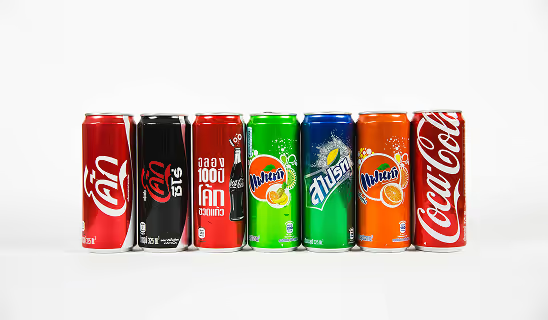











Alright, you're ready to amp up your brand's game and carve out its spot in the hierarchy?
Here’s your starter pack:
- Nail the Basics: Kick off by getting crystal clear on your brand's core and its extended fam. This is your rock-solid base. Mess this up, and the whole house of cards tumbles.
- Sub-Brands Are Your Secret Weapons: Wanna hit different types of customers right in the feels? Think sub-brands. Say you're all about luxury – why not spin off a few sub-brands for different wallet sizes or product types?
- Brand Extensions: Your Growth Hack: Got a hit product? Time to ride that wave. Expand into new territories – think clothing lines branching into accessories or home decor. It's all about making your brand a regular in people's lives.
- Stay True to Your Roots: Amidst all this growth, don't lose sight of what you stand for. Your brand's core values and mission? They're your North Star. Keep them front and center, and you'll stay solid across all channels.
And hey, there's a whole lot more where that came from.
In this article, we're diving deep into the world of brand hierarchy.
Why should you care?
Because getting this right could be the difference between being a brand that's just there and one that's everywhere.
Let's get into it.
Struggling to Create a Consistent Hierarchy for Your Brand?
The Branded Agency can help you identify the rungs on your brand’s value ladder to create a singular, multi-faceted brand image. Work with us to establish your brand’s authority, increase brand recognition, and drive brand loyalty. Start today by securing your complimentary strategy session on a day and time that aligns with your schedule.
What is Brand Hierarchy?
Think of Brand Hierarchy as the boss-level blueprint of your brand universe.
It’s like a family tree for your biz, showing who’s who and what’s what in your brand world.
This setup is a game-changer, especially if you’re juggling a bunch of product lines or brand personalities.
Take car giants like BMW – they’ve got this down. They use brand hierarchy to line up their rides in the market, making sure each one’s got its own swagger but still rolls with the BMW crew. Various brand hierarchy examples, like BMW, illustrate the importance of a well-defined structure.
Bottom line: Brand hierarchy architecture is about making all your brand bits talk to each other in a way that amps up your business big time.
Why is Brand Hierarchy Important?
Brand hierarchy is one of the most important concepts in marketing and advertising.
Brand hierarchy is the concept that each brand has a position within a brand family.
There are many reasons why it’s essential to clearly understand where each brand sits in your overall portfolio.
The first reason is that it helps you determine which brands should be promoted, which need more investment and attention, and which can be retired or repositioned (assuming they’re not doing well).
The second reason is that it helps you understand how your customers view your products. An overarching brand ensures that each brand aligns with the parent company's core message and values, facilitating clearer consumer recognition and effective communication of brand positioning.
Knowing their perception of each brand, you can tailor your marketing efforts to suit them best.
The third reason is that it helps businesses avoid brand cannibalization, where two or more brands (or products) under the same company compete with each other.
Finally, by knowing where all your brands sit within their category’s hierarchy, you’ll be able to make better strategic decisions about how you differentiate yourself from competitors and market yourself to consumers.
What are the Three Main Types of Brand Hierarchy?

There are three main types of Brand Hierarchy: Corporate Brand (aka Branded House), Endorsed Brand (aka Family Brand), and Individual Brand (aka House of Brands).
These types of brand hierarchies help us decide how to arrange a brand or product within a brand family.
Corporate Brand(Branded House)
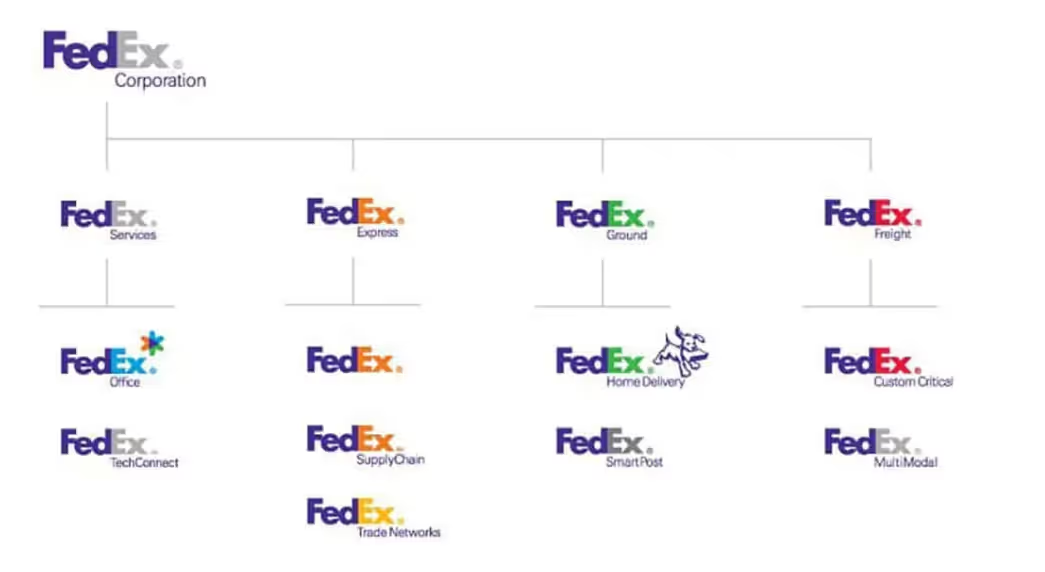
Corporate Brand, also known as the Branded House, is the first type of Brand Hierarchy.
It is the organization's most important brand and represents the master(primary) entity.
An excellent example of a corporate brand is FedEx.
It has multiple business branches, such as FedEx Freight and FedEx Express, that conduct different operations and offer different services, but they are still united under one master brand, FedEx.
The Corporate Brand is often used due to its simplicity and ease of management.
It focuses on a single brand with only one set of branding elements.
Another great example would be General Electric's brand hierarchy, with multiple brands such as GE Security, GE Marine, and GE Aviation, among others, under the master brand.

Endorsed Brand(Family Brand)
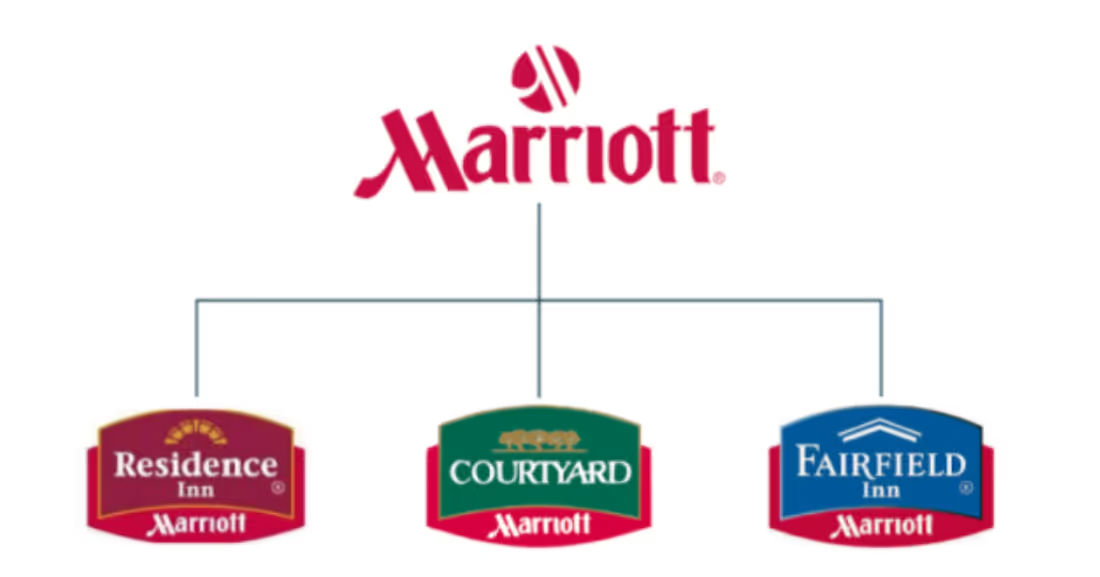
An Endorsed Brand or Family Brand is the second type of Brand Hierarchy.
Here, the corporate brand doesn't take center stage nor stay entirely out of the way of the sub-brands.
The sub-brands are independent but benefit from being under the 'umbrella' of the corporate brand, which is why this type of Brand Hierarchy is also called Umbrella Brand.
A new distinctive brand is created but is 'endorsed' by the corporate entity.
A well-known example of an endorsed brand is Marriott's sub-brands such as Residence Inn, Courtyard, and Fairfield Inn.
These sub-brands are independent entities but still bear Mariott's banner. They benefit from the "Marriott" brand, logo, and identity.
Individual Brand(House of Brands)
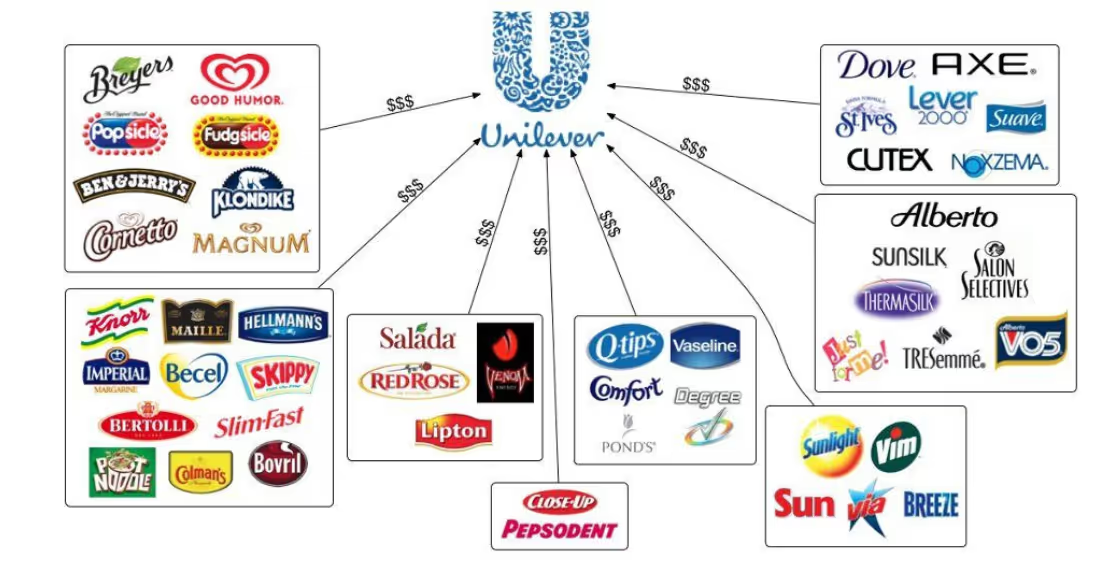
Individual Brand is the third type of Brand Hierarchy. Its brand hierarchy structure focuses on building independent sub-brands, while the corporate brand sits discreetly in the background.
An individual brand represents one service or product within your business.
It is often used with endorsed brands so that customers can quickly identify which person or product they're looking at when browsing through different options available to them at any given time.
Examples of an Individual Brand are the different companies under Unilever.
They are not directly under the company as they operate independently and do not carry the image of its corporate brand.
Want to learn more about brand platforms, Brand Strategy and Brand Identity? Keep reading!
If you need help with your companies brand strategy and identity, contact us for a free custom quote.
Hybrid Brand

A hybrid brand carries the characteristics of either if not all three of the main types of brand hierarchy.
These companies mix and match until they develop a Brand Hierarchy most suitable for them.
An example of this is Google.
The company is a corporate brand with dependent sub-brands such as Google Pay, Google Play, Google Maps, etc. But it also has individual brands such as YouTube.
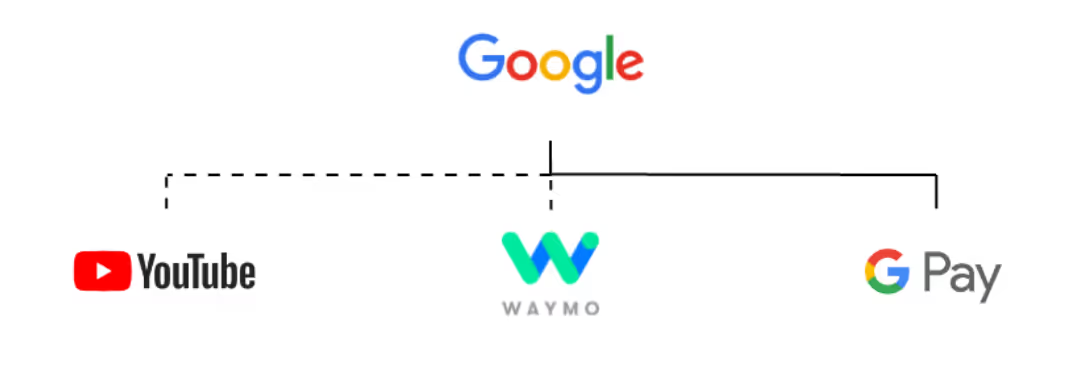
In fact, Google itself is an independent brand under the company, Alphabet.
So Google is technically a hybrid between Corporate and Independent brand.
Another excellent example of a Hybrid Brand is The Coca-Cola Company.
It's the corporate brand of many other popular sub-brands such as Coca-Cola Zero, Coke Diet Coke, and Coke.
The Coca-Cola Company also has the brand hierarchy structure of an individual brand with sub-brands such as Honest Tea, Fuze, and Smart Water that most people would not think are related to Coca-Cola.
Product Modifier and Descriptor
Brand Hierarchy does not just exclusively refer to companies but also to the products or services a company offers.
The lines between Corporate and Endorsed brands usually blur at this point.
It is better to divide brand hierarchy between the company and product levels for less confusion.
In this case, Product Modifier and Descriptor can be considered at the bottom level of the brand hierarchy.
It aids consumers in distinguishing between the various products or services sold under each brand.
Modifiers distinguish a product or service from precisely what customers expect for a version. For instance, YouTube has modifiers such as YouTube Gaming, YouTube Kids, and YouTube gaming.
Another more relatable example is the different flavors of the popular snack, Lay's.
We have Lay's Classic, Lay's Barbecue, and Lay's Sour Cream & Onion, among many others.
As for descriptors, it is not a different brand entirely but helps distinguish the brand or product more precisely.
Let's use an Apple iPhone 13 Pro to give an example detailing all the levels in the brand hierarchy.

Apple is the company behind it all which makes it our Corporate Brand. In this case, both the Corporate and Endorsed Brands are the same.
The iPhone is an individual brand, with the product type being all phones.
The modifier of 13 distinguishes it from all the other iPhones that Apple has produced, while the descriptor further distinguishes it from all the other iPhone 13s.
If you're still confused, you can check more examples of successful sub-brands or contact us at The Branded Agency where we would be happy to answer your questions.
Product modifiers and descriptors, and Brand Hierarchy in general, are also essential in identifying product hierarchy.
What is the difference between Brand Hierarchy and Brand Identity?
Brand hierarchy is a set of brand names and their associated products or services.
It is a type of brand architecture that organizes brands into hierarchies to reflect the relative importance of each brand in relation to other brands in the same category. Family brands serve as distinct entities under a corporate umbrella, helping to segment product lines and target various consumer preferences, thereby enhancing brand recognition and loyalty.
When a brand hierarchy is successful, it helps consumers understand what they are buying and makes it easier for marketers to manage their brands.
Brand identity is an intangible asset that represents the core values of your company, product, or service. Brand identity can be visual, verbal, or behavioral.
It involves multiple elements like logo design, color scheme, tagline, etc.
Brand identity helps build long-term customer relationships by connecting them with your brand through various touchpoints such as websites, social media platforms, etc.
Did you learn everything you need to know about Brand Hierarchy?
Effective brand hierarchy can infuse new life into your marketing strategy.
A powerful hierarchy can set you apart from your competition and raise the value of your business.
In effect, it can make you more efficient, profitable, and attractive to consumers across all channels of your marketing communications program.
Need help with creating a brand hierarchy strategy for your business? We got you covered!
Here at The Branded Agency, we help you with virtually anything related to branding your business and keeping it at the top.
Don't hesitate to contact us!
Frequently Asked Questions (FAQ) - Brand Hierarchy: Setting Yourself Apart in a Crowded Marketplace

1. Why is Brand Hierarchy important?
Brand hierarchy is crucial because it helps businesses differentiate their products and services in a crowded marketplace. A well-defined brand hierarchy improves brand recognition, strengthens customer loyalty, and allows for better brand management. It also helps prevent brand cannibalization, where different brands within the same company might compete against each other.
2. How does Brand Hierarchy relate to Brand Identity?
Brand hierarchy and brand identity are interconnected. While brand hierarchy organizes the relationships between different brands within a portfolio, brand identity encompasses the visual, verbal, and behavioral elements that define a brand’s distinct character. A cohesive brand hierarchy supports a unified brand identity, ensuring that each sub-brand or product aligns with the core brand’s values and messaging.
3. What is the difference between a Corporate Brand and an Individual Brand?
A Corporate Brand (Branded House) refers to a single brand that encompasses all products and services, creating a unified image. For example, Google oversees several services like Google Maps and Google Play under its corporate brand.
An Individual Brand (House of Brands) operates as an independent entity, often with no obvious connection to the parent company. For instance, Unilever owns brands like Dove and Axe, which are marketed separately and have distinct identities.
4. How do sub-brands fit into the Brand Hierarchy?
Sub-brands are essential components of a brand hierarchy. They allow a company to target different market segments with tailored offerings while still benefiting from the parent brand’s reputation. Sub-brands can vary in their independence, ranging from closely linked to the parent brand (endorsed brands) to fully autonomous (individual brands).
5. What should I do if I’m struggling to manage my brand hierarchy?
If you're finding it challenging to maintain a consistent brand hierarchy, it may be time to consult with branding professionals. The Branded Agency offers complimentary strategy sessions to help you identify the key elements of your brand hierarchy, improve brand recognition, and drive customer loyalty. Reach out to us to get started on creating a well-defined brand architecture that sets you apart from the competition.
6. What are the benefits of a well-structured Brand Hierarchy?
A well-structured brand hierarchy offers several benefits:
- Enhanced Brand Recognition: Consumers can easily identify and associate products with the parent brand.
- Effective Brand Management: Streamlines marketing strategies and reduces confusion across different brand elements.
- Customer Loyalty: Consistency in brand messaging and values builds trust and loyalty among customers.
- Market Flexibility: Enables the brand to expand into new markets or product lines without diluting the core brand’s identity.

Sloane Avery
As entrepreneurs, they’ve built and scaled their own ventures from zero to millions. They’ve been in the trenches, navigating the chaos of high-growth phases, making the hard calls, and learning firsthand what actually moves the needle. That’s what makes us different—we don’t just “consult,” we know what it takes because we’ve done it ourselves.
Want to learn more about brand platform?
If you need help with your companies brand strategy and identity, contact us for a free custom quote.
We do great work. And get great results.
+2.3xIncrease in revenue YoY
+126%Increase in repurchase rate YoY








+93%Revenue growth in first 90 days
+144% Increase in attributed revenue


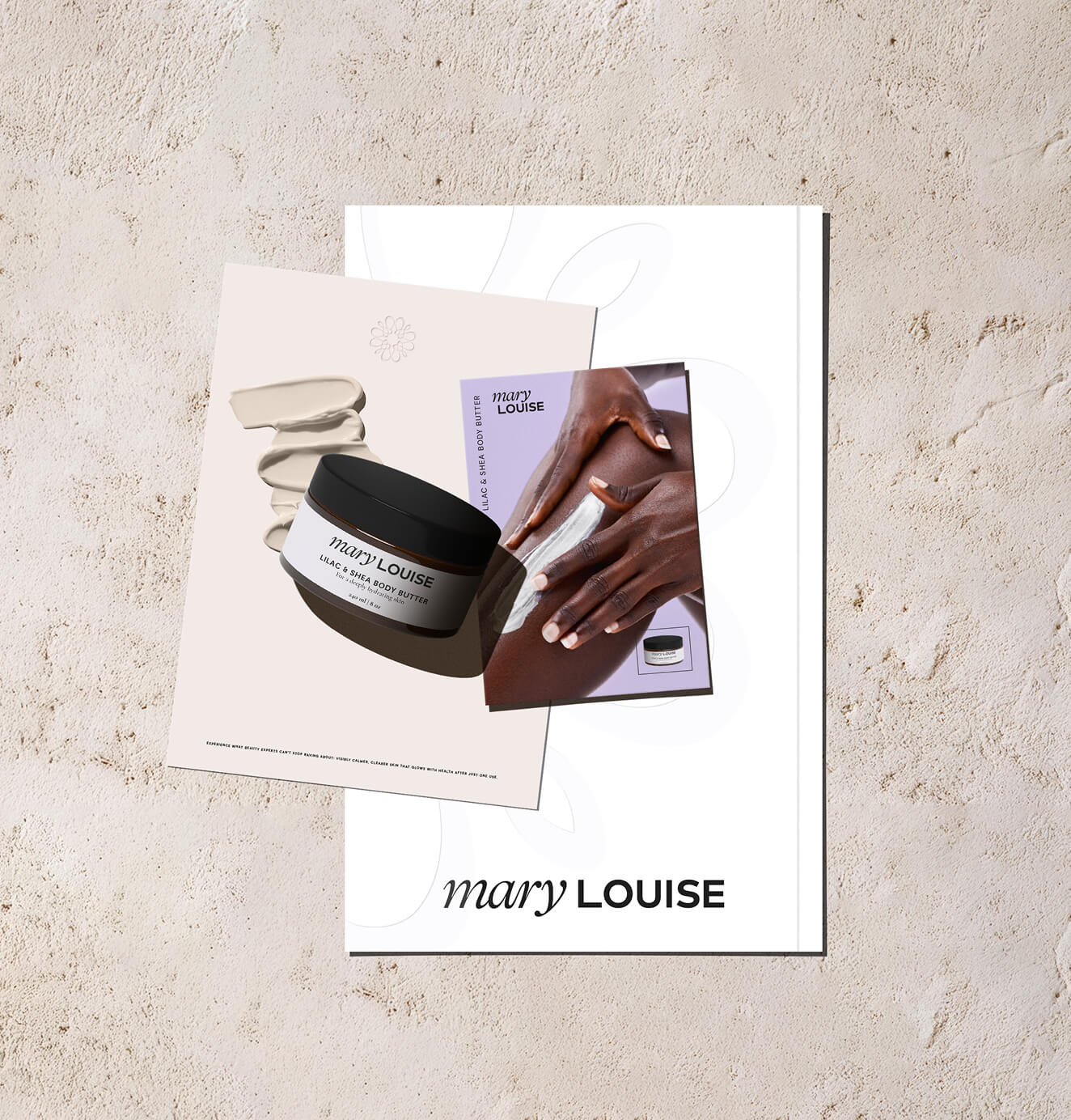





+91%Increase in conversion rate
+46%Increase in AOV








+200%Increase in conversion rate
+688%Increase in attributed revenue












